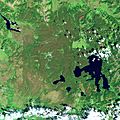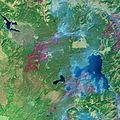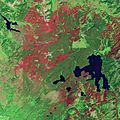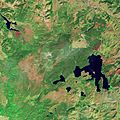Yellowstone fires of 1988 facts for kids
The Yellowstone fires of 1988 were the biggest wildfires ever seen in Yellowstone National Park. They started as small, separate fires. But they quickly grew out of control. Strong winds and a very bad drought (a long time with no rain) in the Western United States made the fires much worse.
The fires burned for several months. On September 8, 1988, the whole park was closed to everyone except emergency workers. This was the first time in Yellowstone's history this had happened. Cooler, wet weather in the late autumn finally helped put the fires out.
Contents
What Caused the Yellowstone Fires?
The fires began in different ways. Some were started by lightning, which is a natural cause. Other fires were started by people, sometimes by accident. Because the summer of 1988 was very dry and windy, even small sparks could quickly turn into huge blazes.
How Drought and Wind Made Fires Worse
A severe drought meant that trees, grass, and plants were very dry. They were like kindling, ready to burn. Strong winds then helped the fires spread incredibly fast. The wind carried sparks and flames over long distances, starting new fires far away from the main ones. This made it very hard for firefighters to control them.
Fighting the Massive Fires
Thousands of firefighters came to Yellowstone to help. They worked tirelessly to stop the flames from reaching important buildings and popular areas. They used special equipment like fire engines, helicopters, and airplanes to drop water and fire retardant (a chemical that slows down fire).
Protecting Park Buildings and Wildlife
Firefighters built firebreaks, which are clear areas where all plants are removed, to stop the fire from spreading. They also sprayed water and foam on buildings to protect them. While some animals were able to escape the fires, others were sadly caught in them. However, many animals, like elk and bison, moved to safer areas.
Impact on Yellowstone National Park
The fires burned about 793,880 acres of land. This is almost 36% of the entire park! The smoke from the fires was so thick that it covered the sky for miles around. It was a scary time for people living near the park and for visitors.
How the Park Recovered
Even though the fires looked very destructive, they are a natural part of a forest's life cycle. Many trees, like the lodgepole pine, need fire for their seeds to open and grow. After the fires, the park slowly started to recover. New plants began to grow, and animals returned to the burned areas. The fires helped to clear out old, dead trees and make way for new, healthy growth. This shows how nature can heal itself over time.
Images for kids
-
1965: typical Yellowstone lodgepole pine forest
-
Firefighters on the fireline near Mammoth Hot Springs, September 10, 1988
-
Smoky conditions obscured the Absaroka Mountains.
See also
 In Spanish: Incendio de Yellowstone de 1988 para niños
In Spanish: Incendio de Yellowstone de 1988 para niños












